

What is Heat Transfer? Heat Transfer Experiments
Heat transfer projects are an exciting and engaging choice for your next STEM activity. Kids love the hands on nature of these projects. Plus they offer a lot of practical life skills. Like how to build a natural solar heater or how to slow heat loss, or how to make a slurpee with science !
Science Fair Heat Transfer Experiments
Table of Contents

Heat Transfer Science and Definitions
Before jumping into a bunch of Heat Transfer Projects it’s a good idea to chat about the science behind these experiments.
Heat Energy is often called thermal energy. Thermal energy is present in the molecules of an object. When an object is hot the molecules have a lot of energy and move fast. When an object is cold, the molecules have little energy and move slowly.
One thing to keep in mind, is that the faster molecules are moving, the more space they take up. The Bottle Crush experiment below is a fantastic way to demonstrate this principle.
How is Heat Transferred?
The Second Law of Thermodynamics states that heat will always move from a hot object to a cooler one. Heat transfer is the movement of thermal energy as it transfers from one object to another or between an object and it’s surroundings. Thermal energy will naturally work towards a state of balance or equilibrium. This is known as thermal equilibrium, where two objects or an object and it’s surroundings achieve the same level of heat energy (thermal energy).
Keep in mind the greater the difference in temperature the more rapid the transfer of heat. The Mpemba Effect is a great way to explore this principle in water.
What is the Difference Between Heat and Temperature?
It’s important not to confuse Heat and Temperature. Heat refers to the energy present in the molecules of an object (picture how fast those molecules are moving). Heat is affected by the speed of the particles, the number of particles (including their size or mass), and the type of particles. Temperature is a measure of the average kinetic energy of the molecules in an object and is not affected by the number or size of the molecules. Heat and temperature are directly related to each other, but not the same thing.
Picture a steaming mug of coffee, now picture a bathtub filled with the same steaming coffee. The temperature is the same, but the thermal energy is higher in the tub because there is more coffee.
In a nutshell, heat is energy. Temperature is a measurement of that energy.
So with these heat transfer projects we are exploring the transfer of energy, with temperature being a common method of measurement and quantification of the results.
Heat Transfer Projects and Experiments
Science fair worthy projects, greenhouse effect experiment – climate change in a jar.
In this climate change experiment students learn hands on about the power of greenhouse gases and how they capture and hold heat from the sun. A simple chemical reaction is all that is needed to replicate the carbon dioxide in the atmosphere and see the greenhouse effect in a jar .

Starlite Thermal Insulating Experiment
This project is absolutely fascinating and would make an amazing science fair project for middle grade. Our Starlite recipe uses ingredients that you probably already have and it provides incredible thermal protection from heat transfer. We tested it a number of different ways, and each was utterly fascinating!
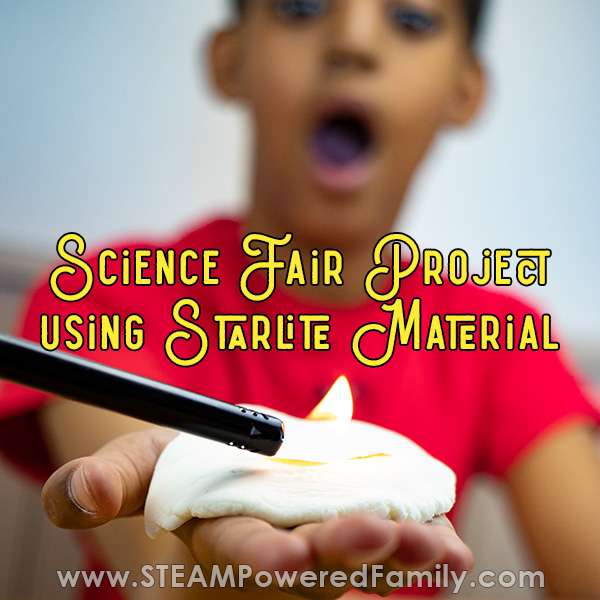
Passive Solar Energy Project
This activity uses recycled materials to create a solar chimney . Using the energy from the sun, it is transferred to the air inside the chimney, heating the air.

Winter STEM – Exploring the Effect of Salt on Ice
A fun project that explores how salt impacts ice and the transfer of heat between the ice and adjacent objects and the surroundings.

Slurpee Science
Using the principles explored in the previous Winter STEM project, this heat transfer project has a tasty treat at the end as students make their own slurpees with science !

How to Make Ice Cream in a Bag
Want something other than a slurpee? Try making Ice Cream in a Bag using the principles of Heat Transfer and a little muscle power. We have recipes for regular and dairy free Ice Cream in a Bag. So yummy!

Why Does Water Rise?
This activity is like magic and a great example of how rapid changes in heat energy and temperature can create a vacuum.

More Fun Heat Transfer Projects
Color changing magic playdough recipe.
A wow worthy project making playdough that changes colour as you play, simply from the heat of your hands, or by using chilled or warmed objects. This Magic Playdough Recipe is so cool!

Heat Sensitive Color Changing Oobleck Recipe
Looking to add some non-Newtonian Fluid demonstrations to your heat transfer lessons? Try this fun Colour Changing Oobleck that changes colours from the warmth of your hands, especially as you work it to keep it in a solid state. But release it and watch as it turns to liquid, flowing from your hands and changes colour as it flows. A fantastic demonstration of heat transfer and non-Newtonian fluids.
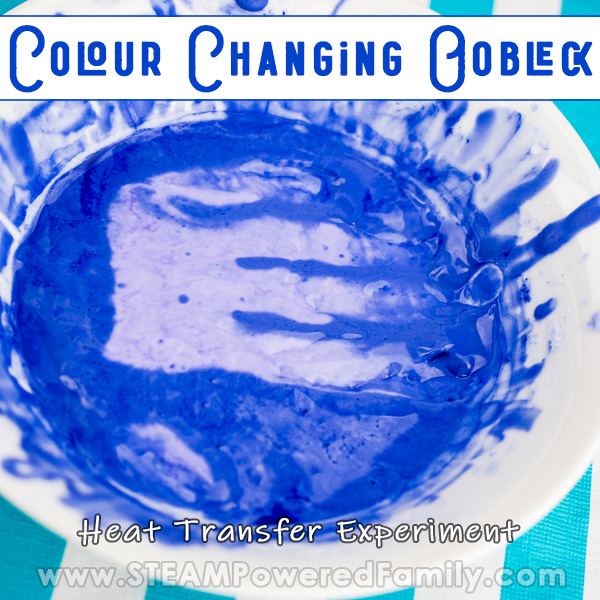
Magic Moon Dough
This luxurious sensory activity is absolutely mesmerizing. As you play with the silky feeling magic moon dough it will change colour from your touch, just like magic! Takes only minutes to make and provides hours of play.
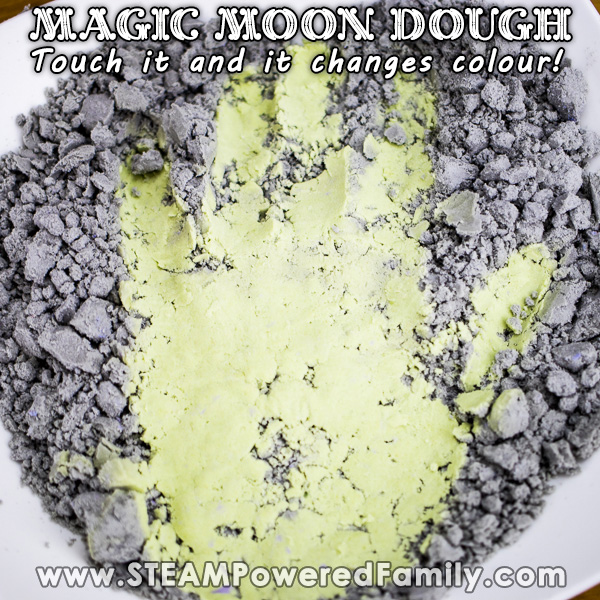
Bottle Crush
This activity was mentioned above. Bottle Crush is a very simple science project that kids of all ages will enjoy. It does a fantastic job of showing how high heat energy takes up more space and low heat energy takes up less space.
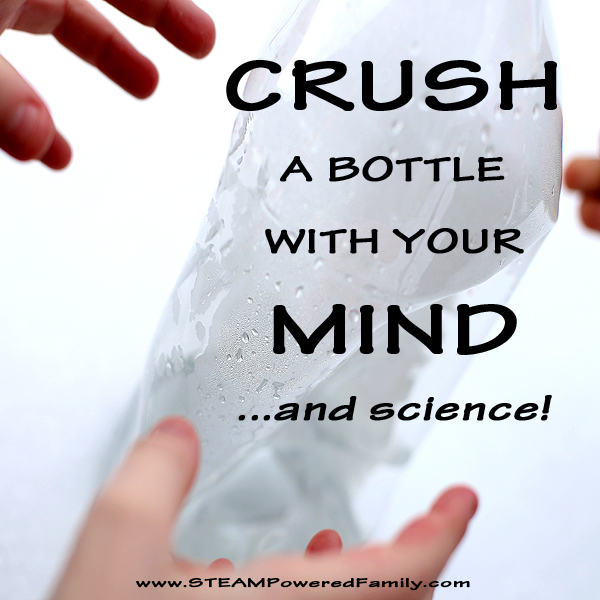
Mpemba Effect – Making Snow
The Mpemba Effect is about the peculiar property of water where it will freeze faster when it is hotter, rather than colder. The greater the difference in temperature, the faster the heat transfer and the more dramatic the results. And at -40 the results are breathtaking!

Convection Currents Experiment
A potentially messy but fun experiment that shows how heat transfers between liquids when they are mixed together.
Ocean Currents Experiment
Similar to the experiment above, this one also explores heat transfer in liquids and how liquids at extreme temperature differences react to each other.
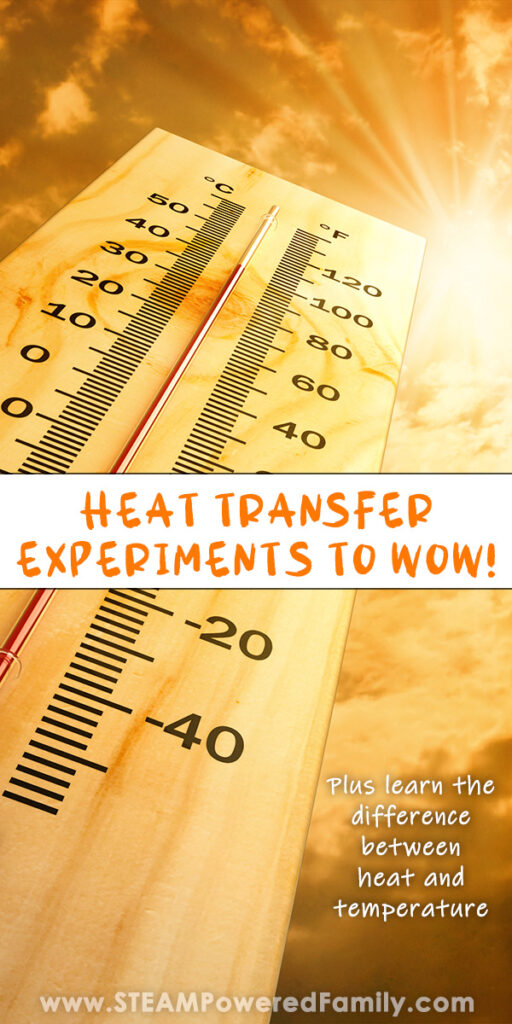
5 Days of Smart STEM Ideas for Kids
Get started in STEM with easy, engaging activities.
Thermal Dynamics Experiments For Kids

Thermal dynamics, also called thermodynamics, is the process of how heat is transferred from one area to another. Heat is a form of energy, which means that the transfer of heat is actually the transfer of energy. For this reason, the study of thermodynamics is actually the study of how and why energy moves in and out of systems. There are a variety of different experiments that can be effective in explaining thermodynamics to children.
Explaining Thermodynamics
Before conducting experiments, children first need to understand the three laws of thermodynamics. The first law of thermodynamics states that any change in the internal energy of a system is equal to the system minus the work that's done by the system. The second law states that heat can never be transferred from a colder body to a warmer one. The third law of thermodynamics refers to the state of entropy, or randomness, in which a system, as it approaches a temperature of absolute zero, is forced to draw energy from other nearby systems; however, as it draws energy from these systems, it will never reach absolute zero, making the third law of thermodynamics a physical impossibility.
Homemade Ice Cream
A fun, and delicious, experiment kids can undertake is to make homemade ice cream, using a recipe found on the Kelvin's Kids Club website (zapatopi.net/kelvin/kidsclub). By following the recipe, children will have seen how heat energy in the ice-cream mix flowed into a brine solution, which was at a colder temperature due to the salt that was added to lower its temperature, until both the ice cream and the brine were at the same temperature. The heat of the warmer body transferred to the colder body until both became the same temperature, thus demonstrating the second law of thermodynamics.
Boiling Ice
This experiment looks at why a pot of boiling water suddenly stops boiling when an ice cube is placed in it. Heat a pot of water on a stove until it comes to a steady boil, then place several ice cubes into the pot; the water will immediately stop boiling. This experiment likewise proves the second law of thermodynamics, demonstrating that the heat from the burner will always flow to the coldest object in the pot, which in this case is the ice. Therefore the heat from the burner stops making the water boil as it instead works to make the solid ice melt and become water.
"The Science of Cooking"
More child-appropriate experiments involving thermodynamics can be found in Peter Barnham's book "The Science of Cooking." Barnham, a professor at the University of Bristol, U.K., explains how food preparation and cooking meals involve thermodynamic principles. In the book, Barnham delves into the chemistry of foods, discussing how this contributes to the taste of a particular food. Barnham also explores the role of thermodynamics in cooking, with most chapters featuring a food-based experiment that kids can conduct.
- Physics4Kids.com: Heat and Thermal Energy
- National Aeronautics and Space Administration: What is Thermodynamics?
- Kelvin's Kids Club: Homemade Ice Cream
- Springer: The Sciene of Cooking; Peter Barnham; 2001
Cite This Article
Brent, Michael. "Thermal Dynamics Experiments For Kids" sciencing.com , https://www.sciencing.com/thermal-dynamics-experiments-kids-8650438/. 24 April 2017.
Brent, Michael. (2017, April 24). Thermal Dynamics Experiments For Kids. sciencing.com . Retrieved from https://www.sciencing.com/thermal-dynamics-experiments-kids-8650438/
Brent, Michael. Thermal Dynamics Experiments For Kids last modified March 24, 2022. https://www.sciencing.com/thermal-dynamics-experiments-kids-8650438/
Recommended
All Science Fair Projects
1000 science fair projects with complete instructions.

We also build custom kits!

- Air Pressure Astronomy/Space Back To School Best Sellers Biology/Life Science Blog Books, Music, Software Chemistry Clearance Critical Thinking Custom Kits Density Earth Science/Geology EI Exclusives Electricity & Magnetism Energy Engineering Environmental Science
- Forensic Science Gifts for Geeks Happy Halloween! Home Science Lab Lab Equipment and Safety Light & Color Microscopes & Magnification Nanotechnology New Products Odds & Ends Physics Science Camp Central Science Kits En Español Science Parties Sound & Waves STEM Surprising Science for Kids Ultraviolet
- K-3 3-5 5-8 9-12 College
- We Build Custom Kits Read our Blog Visit the Newsletter Library Free Lesson Ideas Search for NGSS Correlations Watch Our Workshop Videos Webinars Material Safety Data Sheets (MSDS) Science Fair Supplies Product Videos Ted's Vault of Science
- Free DIY Science Kid Friendly Science For Homeschoolers Science Parties
- View / Request Catalog
- Shop by Subject
- Air Pressure
- Astronomy/Space
- Back To School
- Best Sellers
- Biology/Life Science
- Books, Music, Software
- Critical Thinking
- Custom Kits
- Earth Science/Geology
- EI Exclusives
- Electricity & Magnetism
- Alternative/Green Energy [25]
- Amazing Engines [5]
- Energy Conversion [28]
- Gyroscopes & Tops [10]
- Memory / Muscle Wire [3]
- Motion [17]
- Rockets [8]
- Simple Machines [18]
- Solar Energy [13]
- Thermodynamics / Thermal Energy [27]
- Wild Rides [7]
- Engineering
- Environmental Science
- Forensic Science
- Gifts for Geeks
- Happy Halloween!
- Home Science Lab
- Lab Equipment and Safety
- Light & Color
- Microscopes & Magnification
- Nanotechnology
- New Products
- Odds & Ends
- Science Camp Central
- Science Kits En Español
- Science Parties
- Sound & Waves
- Surprising Science for Kids
- Ultraviolet
- Shop by Grade
- College [311]
- The TeacherSource
- We Build Custom Kits
- Visit the Newsletter Library [476]
- Free Lesson Ideas
- Search for NGSS Correlations
- Watch Our Workshop Videos [111]
- Material Safety Data Sheets (MSDS)
- Science Fair Supplies [52]
- Product Videos
- Ted's Vault of Science
- The ParentSource
- Free DIY Science
- Kid Friendly Science [237]
- For Homeschoolers [370]
- Science Parties [37]
- Information
- Shipping Information
- Gift Certificates [1]
- International Orders
- Privacy & Security
- Purchase Orders
- Extra Credit Points®
- Convention Schedule
- Request a Catalog
Thermodynamics / Thermal Energy
- Sort by Product option $-$$$$ $$$$-$ Item # Name Reviews Best Seller Newest On Sale

- Items/Page 24 48 72 96 View All

Drinking Bird Experiment Kit

Wilesco Steam Engines and Parts

PhysicsQuest 2019: Dr. Wu's Secret Project

17" Galileo Thermometer

Thermoelectric Energy Demonstration Kit


Nitinol Spring

Stirling Engine with Alcohol Burner

Thermoplastic Polymer Pigments

Horizontal Hand Boiler Demonstration
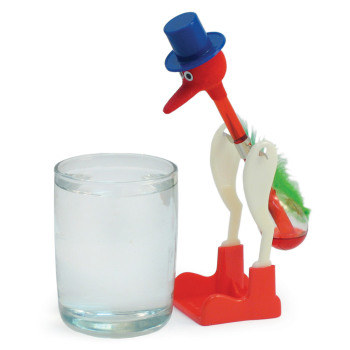
Drinking Bird

Amazing Ice Melting Blocks

Nitinol Memory Wire Samples (pk of 10)

Nitinol Memory Wire by the Foot

Putt Putt Steam Boat

Smashing! Steel Sphere Demo Kit

Fire Syringe Demo

Piezo Popper Kit

Chemical Heat Pack

Heat-Sensitive Pencils

GLOSSY Heat-Sensitive Paper

Liquid Crystal Sheets (12x12 inch)

Touch and See Square

We use cookies to offer an improved online experience and offer you content and services adapted to your interests. By using our site, you are giving your consent to our cookie policy.

on your $50 order!
Unlock VIP deals, free lessons, and exclusive sales offers!
+ Free Shipping on prepaid web orders above $99

Teacher Resource Center
Pasco partnerships.

2024 Catalogs & Brochures
Complete experiments: thermodynamics.
Capstone 'EX' experiments include all the apparatus, sensors (when needed), manuals, and PASCO Capstone files you'll need in your student physics lab. For your convenience, we've listed all the downloadable files for each experiment below.
Grade Level: College
Subject: Physics
01) Electrical Equivalent of Heat
The purpose of this experiment is to determine the amount of electrical energy that is equivalent to a certain amount of thermal energy. This is accomplished by measuring the amount of electrical energy used in the heating resistor to heat water and the resulting thermal energy added to the water. Also, the number of Joules in one calorie is determined.
02) Specific Heat
The purpose of this activity is to determine the specific heat of a metal object and see how that can help identity the metal. A Temperature Sensor is used to measure the change in temperature of a known quantity of water when a metal object of known mass and known initial temperature is put into the water.
03) Electrical Equivalent of Heat - Wireless
The purpose of this experiment is to determine the amount of electrical energy that is equivalent to a certain amount of thermal energy. This is accomplished by measuring the amount of electrical energy used in the heating resistor to heat water and the resulting thermal energy added to the water.
04) Ideal Gas Law
The temperature, volume, and pressure of a gas are measured simultaneously to show that they change according to the Ideal Gas Law. Special cases of constant volume and constant temperature are also investigated.
05) Specific Heat - Wireless
In this activity you will use a temperature sensor to measure the temperature change of a volume of cool water when a hot piece of metal is placed in it. Your data will be used to determine the total amount of heat transferred from the warmer metal to the colder water, which will in turn be used to determine the specific heat of the metal sample.
06) Ideal Gas Law - Wireless
The temperature, volume, and pressure of a gas are measured simultaneously to show that they change according to the Ideal Gas Law. Special cases of constant volume and constant temperature are also investigated. In addition, the value of Absolute Zero is determined.
07) Ratio of Specific Heats of a Gas
A cylinder is filled with air and a Pressure Sensor is attached. The piston is plucked by hand and allowed to oscillate. The oscillating pressure is recorded as a function of time and the period is determined. The ratio of specific heat capacities is calculated using the period of oscillation, according to Ruchhardt's method.
08) Ratio of Specific Heats - Wireless
A cylinder is filled with air and a Wireless Pressure Sensor is attached. The piston is plucked by hand and allowed to oscillate. The oscillating pressure is recorded as a function of time and the period is determined. The ratio of specific heat capacities is calculated using the period of oscillation, according to Ruchhardt's method.
09) Heat Engine Cycle
A heat engine is a device that does work by extracting thermal energy from a hot reservoir and exhausting thermal energy to a cold reservoir. In this experiment, the heat engine consists of air inside a cylinder which expands when the attached can is immersed in hot water. The expanding air pushes on a piston and does work by lifting a weight. The heat engine cycle is completed by immersing the can in cold water, which returns the air pressure and volume to the starting values.
10) Heat Engine Cycle - Wireless
A P-V diagram is generated as a heat engine is taken through a cycle. From this diagram, the heat added to the gas and the work done by the engine are measured to determine the efficiency of the engine. This actual efficiency is compared to the theoretical maximum efficiency.
11) Blackbody Radiation
The spectrum of an incandescent light bulb is scanned by hand using a prism spectrophotometer that measures relative light intensity as a function of angle. A Broad Spectrum Light Sensor is used with a prism so the entire spectrum from approximately 400 nm to 2500 nm can be scanned without the overlapping orders caused by a grating. The wavelengths corresponding to the angles are calculated using the equations for a prism spectrophotometer.

Account Required
Downloading files for this experiment requires a PASCO account.
Experiment Features
Teacher files, sparkvue files, pasco capstone files, wireless sensors, pasport sensors, scienceworkshop sensors.
Many lab activities can be conducted with our Wireless , PASPORT , or even ScienceWorkshop sensors and equipment. For assistance with substituting compatible instruments, contact PASCO Technical Support . We're here to help.

COMMENTS
Explore thermodynamics, how energy is changed from other forms (like radiant energy from the sun) to heat. Measure how the sun's energy strikes an everyday object and becomes transformed as infrared photons, which you can measure as heat. Or experiment with how to keep things cool.
Free STEM Activities to Teach about Thermal Energy and Heat. The following hands-on science activities from Science Buddies' library of STEM Activities for Kids can be used with students in or out of the classroom to explore thermal energy and heat science:. Bake Your Ice Cream: discover how meringue can serve as an insulator to prevent ice cream from melting in the oven.
The Second Law of Thermodynamics states that heat will always move from a hot object to a cooler one. Heat transfer is the movement of thermal energy as it transfers from one object to another or between an object and it's surroundings. ... Convection Currents Experiment. A potentially messy but fun experiment that shows how heat transfers ...
This is a modern version of a classic experiment by Jacques Charles on the volume of a gas at different temperatures. Charles discovered the relationship between volume and temperature of gases that now bears his name. This project shows you a simple method for re-creating this famous experiment. Read more
Before conducting experiments, children first need to understand the three laws of thermodynamics. The first law of thermodynamics states that any change in the internal energy of a system is equal to the system minus the work that's done by the system. The second law states that heat can never be transferred from a colder body to a warmer one.
80+ Physics Projects for Kids How to use this guide. The physics projects for kids featured here are sorted by branches of physics and subcategories as follows (click on the topic to skip to that section):. Mechanics and Motion: Work & Energy, Newton's Law's of Motion, Radial Forces, Gravity, and Balance Electromagnetism & Electricity: Magnetism, Electricity
Heat (Thermodynamics) science fair projects - Heat (Thermodynamics) experiments, Heat (Thermodynamics) projects, Heat (Thermodynamics) projects with full instructions and explanations
Heat and Thermodynamics science fair projects and experiments: topics, ideas, resources, and sample projects.
Handboilers, perfect for teaching about thermal energy, are sold individually and in cases of 12 for your entire class. Heat-Sensitive Pencils will tell you that "you're getting warmer" as you make your point. These thermochromic pencils will actually change color with the heat from your hand! Place your hand on a Touch and See Square and create a beautiful thermal hand print.
Complete Experiments: Thermodynamics. Capstone 'EX' experiments include all the apparatus, sensors (when needed), manuals, and PASCO Capstone files you'll need in your student physics lab. ... In this activity you will use a temperature sensor to measure the temperature change of a volume of cool water when a hot piece of metal is placed in it ...